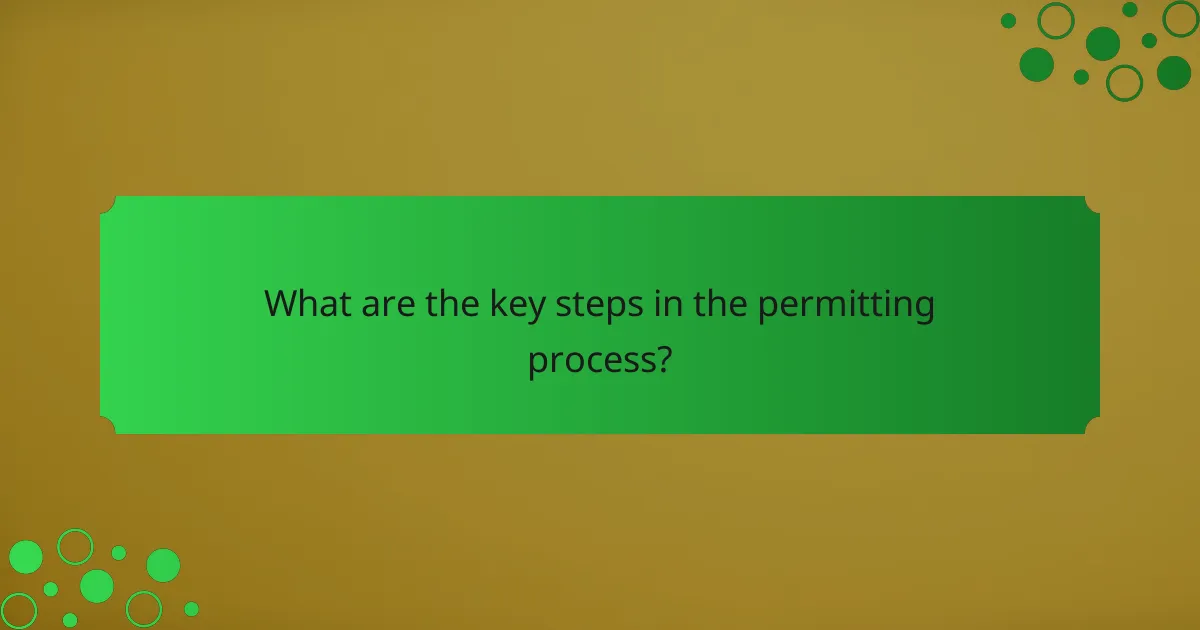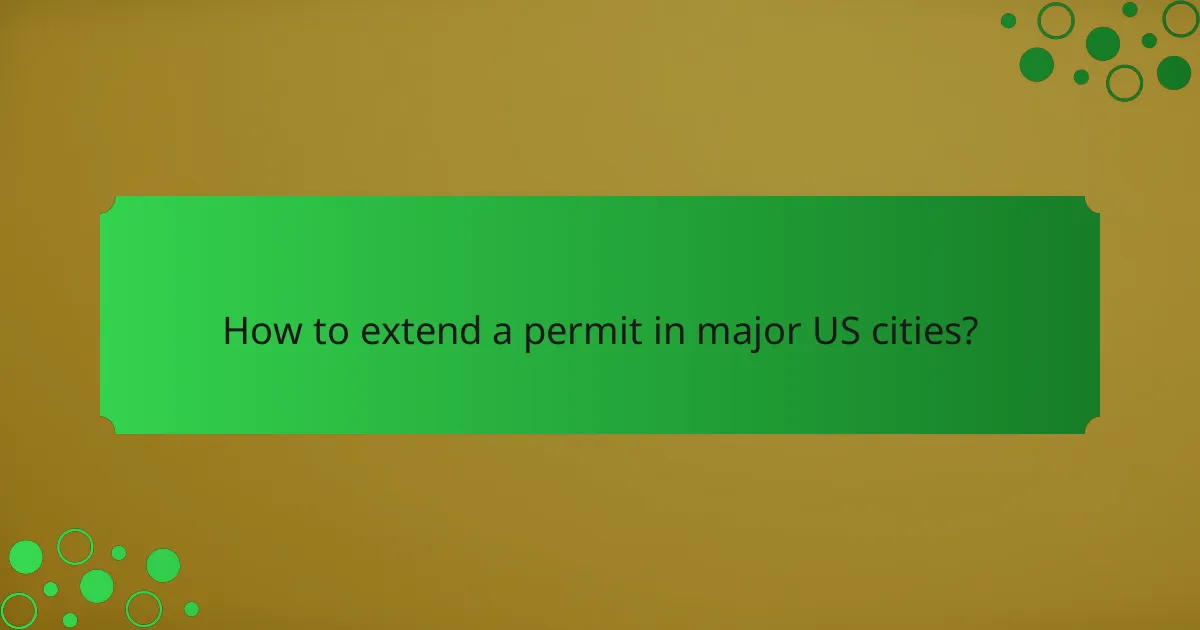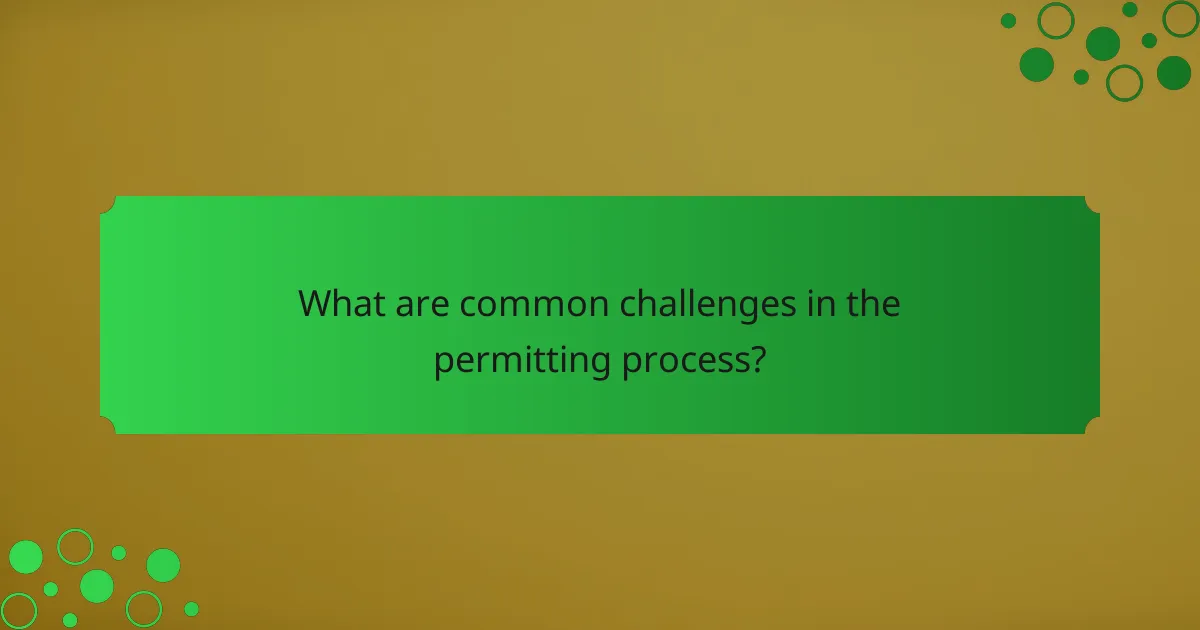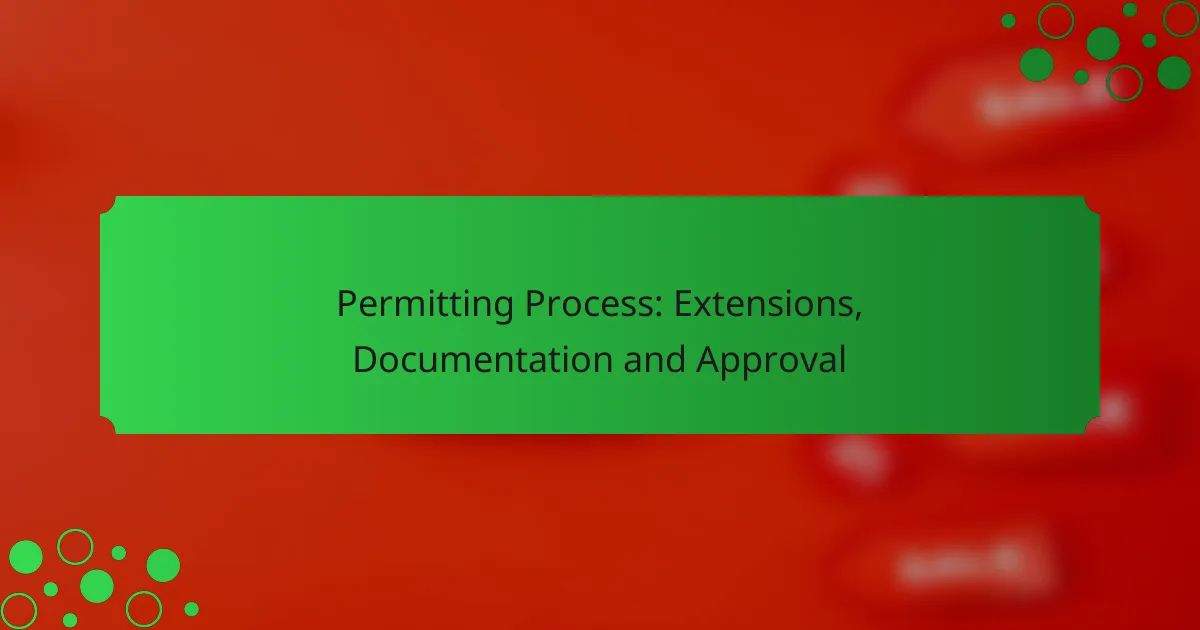The permitting process is crucial for ensuring that projects comply with local regulations and standards, involving several key steps that can facilitate timely approvals. Essential documentation, such as site plans and environmental assessments, is required to support applications. Additionally, if a permit extension is needed, submitting a formal application with updated documents and fees is typically necessary, though specific requirements may vary by city.

What are the key steps in the permitting process?
The permitting process involves several essential steps that ensure compliance with local regulations and standards. Understanding these steps can help streamline the application and approval process, ultimately leading to timely project initiation.
Application submission
The first step in the permitting process is the submission of the application. This typically requires filling out specific forms and providing detailed information about the project, including plans, specifications, and any necessary supporting documents.
Ensure that all required documentation is complete and accurate to avoid delays. Missing information can lead to rejection or requests for additional data, prolonging the process.
Review by authorities
Once submitted, the application undergoes a review by relevant authorities, which may include zoning boards, environmental agencies, and safety inspectors. This review assesses compliance with local laws and regulations.
During this phase, authorities may request further information or modifications to the project. Be prepared to respond promptly to any inquiries to keep the review process moving smoothly.
Approval notification
Understanding the conditions of approval is crucial, as failure to comply can result in permit revocation or additional penalties. Keep a record of all communications during this stage.
Issuance of permit
If approved, the permit is formally issued, allowing the project to proceed. This document outlines the scope of work permitted and any stipulations that must be followed during construction.
It is essential to keep the permit on-site during the project and adhere strictly to its terms to avoid legal issues or fines.
Post-approval compliance
After the permit is issued, ongoing compliance with local regulations is necessary. This may involve inspections at various project stages to ensure adherence to safety and environmental standards.
Stay informed about any additional requirements or changes in regulations that may affect your project. Regular communication with local authorities can help prevent compliance issues down the line.

What documentation is required for permitting?
Permitting requires various types of documentation to ensure compliance with local regulations and standards. Key documents typically include site plans, environmental assessments, construction drawings, proof of ownership, and financial assurances.
Site plans
Site plans are essential for illustrating the layout of a proposed project. They should include details such as property boundaries, existing structures, and the location of utilities. Ensure that your site plan adheres to local zoning requirements and is drawn to scale.
When preparing a site plan, consider including topographical information and any landscaping features. This will help reviewers understand how the project fits within the surrounding environment.
Environmental assessments
Environmental assessments evaluate the potential impacts of a project on the surrounding ecosystem. These assessments may be required by local, state, or federal regulations, depending on the project’s scope and location.
Common components of an environmental assessment include studies on wildlife, vegetation, water quality, and air quality. Be prepared to address any mitigation measures that may be necessary to minimize negative impacts.
Construction drawings
Construction drawings provide detailed specifications for the project’s design and construction. These drawings should include architectural, structural, mechanical, and electrical plans, clearly indicating dimensions and materials.
Ensure that your construction drawings comply with local building codes and standards. Incomplete or unclear drawings can lead to delays in the permitting process, so clarity is crucial.
Proof of ownership
Proof of ownership is necessary to confirm that the applicant has legal rights to the property. This documentation typically includes a title deed or a recent property tax statement.
In some cases, if the property is leased, a copy of the lease agreement may also be required. Ensure that all ownership documents are current and accurately reflect the property in question.
Financial assurances
Financial assurances demonstrate that the applicant has the necessary funds to complete the project and address any potential liabilities. This may include performance bonds, letters of credit, or cash deposits.
Check with local authorities for specific requirements regarding financial assurances, as these can vary widely. Providing adequate financial backing can help expedite the permitting process and build trust with regulatory agencies.

How to extend a permit in major US cities?
To extend a permit in major US cities, you typically need to submit a formal application along with updated documentation and pay any associated fees. The process varies by city, but understanding the key steps can help streamline your request.
Application for extension
The application for a permit extension usually requires you to fill out a specific form provided by the local permitting authority. This form often asks for details about the original permit, reasons for the extension, and any changes in project scope.
Be sure to check the city’s official website for any additional requirements or specific forms needed. Some cities may allow online submissions, while others might require in-person visits.
Submission of updated documentation
Along with your application, you will need to submit updated documentation that supports your request for an extension. This may include revised project plans, timelines, or any new compliance information relevant to your permit.
Ensure that all documents are current and clearly labeled. Incomplete or outdated documentation can lead to delays or denial of your extension request.
Fees for extension
Most cities charge a fee for processing permit extensions, which can vary widely. Fees may range from a nominal amount to several hundred dollars, depending on the type of permit and the city’s regulations.
Check the specific fee schedule on your city’s permitting website to avoid surprises. Some jurisdictions may offer fee waivers under certain conditions, so inquire if applicable.
Review timeline
The review timeline for permit extensions can differ significantly between cities. Generally, you can expect a review period from a few weeks to a couple of months, depending on the complexity of your request and the city’s workload.
To expedite the process, submit your application and documentation as early as possible and follow up with the permitting office to ensure everything is in order. Keeping communication open can help address any issues promptly.

What are common challenges in the permitting process?
Common challenges in the permitting process include delays in approvals and incomplete applications. These issues can significantly prolong project timelines and increase costs, making it crucial for applicants to understand and navigate these hurdles effectively.
Delays in approvals
Delays in approvals can stem from various factors, including bureaucratic inefficiencies, insufficient staffing, or the need for additional reviews. These delays can extend the permitting timeline from weeks to several months, depending on the complexity of the project and the local regulatory environment.
To mitigate delays, applicants should ensure all required documentation is submitted correctly and on time. Engaging with local authorities early in the process can also help identify potential bottlenecks and streamline communication.
Incomplete applications
Incomplete applications are a frequent cause of permitting delays, as they often require resubmission and additional reviews. Missing information can range from basic project details to specific technical data, which can lead to significant setbacks in the approval process.
To avoid this issue, applicants should create a checklist of all required documents and information before submission. Reviewing application guidelines thoroughly and consulting with experienced professionals can help ensure that all necessary components are included, reducing the likelihood of delays due to incomplete applications.
